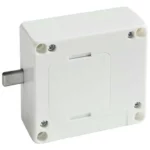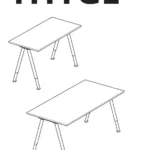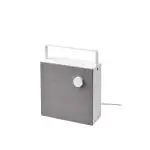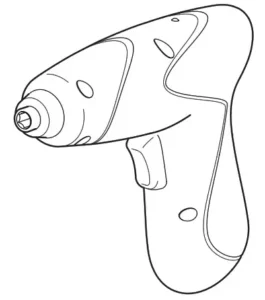

FIXA
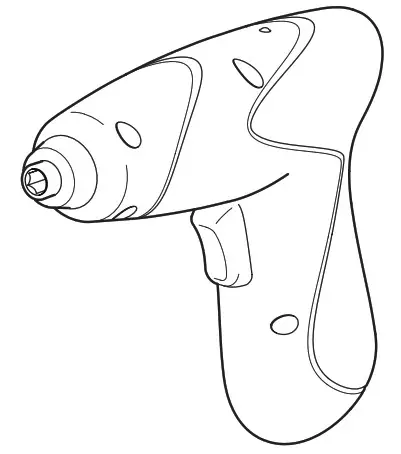

Design and Quality
IKEA of Sweden

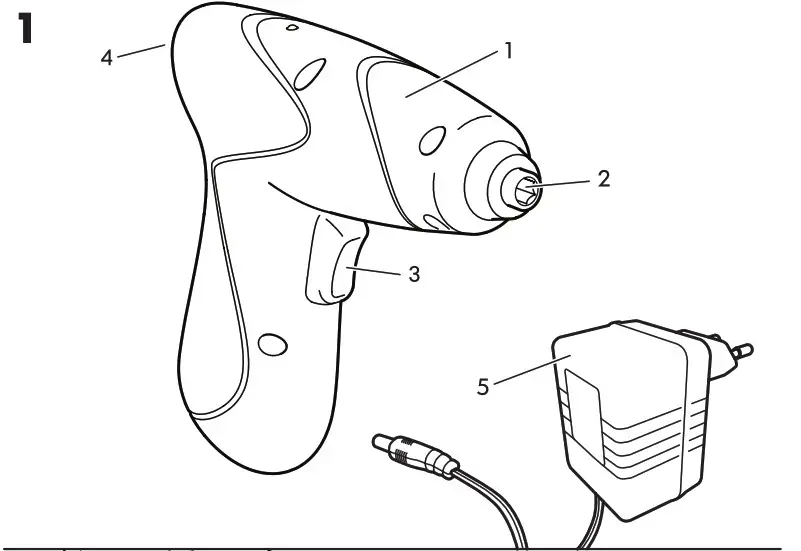
Original instructions
FIXA Cordless screwdriver
TECHNICAL SPECIFICATIONS
Charger input voltage: Local input voltage
Charger output voltage: 6.5 Vd.c.
Battery voltage/ battery type: 3.6 V lithium-ion battery
Charging time: 5-8 hours
Max. torque: 3 Nm
Max no load speed: 200 rpm
Bit holder: 6.35 mm (1/4″)
Vibration :
Screwdriving without impact: ah=0.2 m/s², K=1.5 m/s².
Noise : Noise pressure level Lpa = 58 dB (A), Kpa = 3 dB (A) Noise power level Lwa = 69 dB (A), Kwa = 3 dB (A)
LIST OF FEATURES
The numbering of the product features shown refers to the illustration no. 1 on the graphic page.
- Screwdriver main body.
- Screwdriver bit holder.
- Forward/reverse switch.
- Charging socket.
- Charger.
Intended use
The electric screwdriver is suitable for the insertion and removal of screws.
GENERAL SAFETY INSTRUCTIONS
General safety instructions for power tools
![]() WARNING!
WARNING!
![]() Read all safety warnings and all instructions.
Read all safety warnings and all instructions.
Failure to follow all the warnings and instructions may result in electric shock, fire and/or serious injury. Save all warnings and instructions for future reference. The term “power tool” in all of the warnings listed below refers to your mains operated (corded) power tool or battery operated (cordless) power tool.
Work area safety
a. Keep work area clean and well lit. Cluttered and dark areas invite accidents.
b. Do not operate power tools in explosive atmospheres, such as in the presence of flammable liquids, gasses or dust. Power tools create sparks which may ignite the dust of fumes.
c. Keep children and bystanders away while operating a power tool. Distractions can cause you to lose control.
Electrical safety
a. Power tool plugs must match the outlet. Never modify the plug in any way. Do not use any adapter plugs with earthed (grounded) power tools. Unmodified plugs and matching outlets will reduce risk of electric shock.
b. Avoid body contact with earthed or grounded surfaces such as pipes, radiators, ranges and refrigerators. There is an increased risk of electric shock if your body is earthed or grounded.
c. Do not expose power tools to rain or wet conditions. Water entering a power tool will increase the risk of electric shock.
d. Do not abuse the cord. Never use the cord for carrying, pulling or unplugging the power tool. Keep the cord away from heat, oil, sharp edges or moving parts. Damaged or entangled cords increase the risk of electric shock.
e. When operating a power tool outdoors, use an extension cord suitable for outdoor use. Use of a cord suitable for outdoor use reduces the risk of electric shock.
f. If operating a power tool in a damp location is unavoidable, use a residual current device (RCD) protected supply. Use of an RCD reduces the risk of electric shock.
Personal safety
a. Stay alert, watch what you are doing and use common sense when operating a power tool. Do not use a power tool while you are tired or under the influence of drugs, alcohol or medication. A moment of inattention while operating power tools may result in serious personal injury.
b. Use personal protective equipment. Always wear eye protection. Protective equipment such as dust mask, non-skid safety shoes, hard hat, or hearing protection used for appropriate conditions will reduce personal injuries.
c. Prevent unintentional starting: Ensure that the switch is in the off-position before connecting to power source and/or battery pack, picking up or carrying the tool. Carrying power tools with your finger on the switch or plugging in power tools that have the switch on invites accidents.
d. Remove any adjusting key or wrench before turning the power tool on. A wrench or a key left attached to a rotating part of the power tool may result in personal injury.
e. Do not overreach. Keep proper footing and balance at all times. This enables better control of the power tool in unexpected situations.
f. Dress properly. Do not wear loose clothing or jewellery. Keep your hair, clothing and gloves away from moving parts. Loose clothes, jewellery or long hair can be caught in moving parts.
g. If devices are provided for the connection of dust extraction and collection facilities, ensure these are connected and properly used. Use of these devices can reduce dust related hazards.
h. Do not let familiarity gained from frequent use of tools allow you to become complacent and ignore tool safety principles. A careless action can cause severe injury within a fraction of a second.
Power tool use and care
a. Do not force the power tool. Use the correct power tool for your application. The correct power tool will do the job better and safer at the rate for which it was designed.
b. Do not use the power tool if the switch does not turn it on and off. Any power tool that cannot be controlled with the switch is dangerous and must be repaired.
c. Disconnect the plug from the power source and/or the battery pack before making any adjustments, changing accessories, or storing power tools. Such preventive safety measures reduce the risk of starting the power tool accidentally.
d. Store idle power tools out of the reach of children and do not allow persons unfamiliar with the power tool or these instructions to operate the power tool. Power tools are dangerous in the hands of untrained users.
e. Maintain power tools. Check for misalignment or binding of moving parts, breakage of parts and any other condition that may affect the power tool’s operation. If damaged, have the power tool repaired before use. Many accidents are caused by poorly maintained power tools.
f. Keep cutting tools sharp and clean. Properly maintained cutting tools with sharp cutting edges are less likely to bind and are easier to control.
g. Use the power tool, accessories and tool bits etc., in accordance with these instructions and in the manner intended for the particular type of power tool, taking into account the working conditions and the work to be performed. Use of the power tool for operations different from those intended could result in a hazardous situation.
h. Keep handles and grasping surfaces dry, clean and free from oil and grease. Slippery handles and grasping surfaces do not allow for safe handling and control of the tool in unexpected situations.
i. Hold the power tool by insulated gripping surfaces, when performing an operation where the fastener may contact with hidden wiring or its own cord. Fasteners contacting a “live” wire may make exposed metal parts of the power tool “live” and could give the operator an electric shock.
Battery tool use and care
a. Recharge only with the charger specified by the manufacturer. A charger that is suitable for one type of battery pack may create a risk of fire when used with another battery pack.
b. Use power tools only with specifically designated battery packs. Use of any other battery packs may create a risk of injury and fire.
c. When battery pack is not in use, keep it away from other metal objects, like paperclips, coins, keys, nails, screws or other small metal objects that can make a connection from one terminal to another. Shorting the battery terminals together may cause burns or a fire.
d. Under abusive conditions, liquid may be ejected from the battery; avoid contact. If contact accidentally occurs, flush with water. If liquid contacts eyes, additionally seek medical help. Liquid ejected from the battery may cause irritation or burns.
Service
- a. Have your power tool serviced by
a qualified repair person using only identical replacements parts. This will ensure that the safety of the power tool is maintained.
MACHINE-SPECIFIC SAFETY INSTRUCTION
Safety warnings for drills and screwdrivers
Use appropriate detectors to determine if utility lines are hidden in the work area or call your local utility company for assistance. Contact with electric lines can lead to fire and electric shock. Damaging a gas line can lead to explosion. Penetrating a water line causes property damage or may cause an electric shock.
Switch off the power tool immediately when the tool insert jams. Be prepared for high reaction torque that can cause kickback. The tool insert jams when:
- the power tool is subject to overload or
- it becomes wedged in the workpiece.
Hold the machine with a firm grip.
High reaction torque can briefly occur while driving in and loosening screws.
Secure the workpiece.
A workpiece clamped with clamping devices or in a vice is held more secure than by hand.
Keep your workplace clean.
Blends of materials are particularly dangerous. Dust from light alloys can burn or explode.
Always wait until the machine has come to a complete stop before placing it down.
The tool insert can jam and lead to loss of control over the power tool.
Avoid unintentional switching on.
Ensure the trigger is in the off position before inserting battery pack. Carrying the power tool with your finger on the trigger or inserting the battery pack into power tools that have the switch on invites accidents.
Safety Warnings for battery chargers
![]() For indoor use only.
For indoor use only.
![]() Double insulated.
Double insulated.
Do not charge other batteries.
The battery charger is suitable only for charging the batteries that were supplied with your power tool. Otherwise there is danger of fire and explosion.
Keep the battery charger clean.
Contamination can lead to danger of an electric shock.
Before each use, check the battery charger, cable and plug. If damage is detected, do not use the battery charger. Never open the battery charger yourself. Have repairs performed only by a qualified technician. Damaged battery chargers, cables and plugs increase the risk of an electric shock.
Do not operate the battery charger on easily inflammable surfaces (e. g., paper, textiles, etc.) or surroundings. The heating of the battery charger during the charging process can pose a fire hazard.
Children should be supervised to ensure that they do not play with the battery charger.
Products sold in GB only: Your product is fitted with an BS 1363/A approved electric plug with internal fuse (ASTA approved to BS 1362). If the plug is not suitable for your socket outlets, it should be cut off and an appropriate plug fitted in its place by an authorised customer service agent. The replacement plug should have the same fuse rating as the original plug. The severed plug must be disposed of to avoid a possible shock hazard and should never be inserted into a mains socket elsewhere. Products sold in AUS only: Use a residual current device (RCD) with a rated residual current of 30 mA or less.
VIBRATION INFORMATION
Vibration level
The vibration emission level stated in this instruction manual has been measured in accordance with a standardised test given in UL 62841 / CSA C22.2 No. 62841. It may be used to compare one tool with another and as a preliminary assessment of exposure to vibration when using the tool for the applications mentioned in this manual. However, using the tool for different applications, or with different or poorly maintained accessories, may significantly increase the exposure level.
An estimation of the level of exposure to vibration should also take into account the times when the tool is switched off or when it is running but not actually doing the job, as this may significantly reduce the exposure level over the total working period.
Protect yourself against the effects of vibration by maintaining the tool and its accessories, keeping your hands warm, and organising your work patterns.
ASSEMBLY
Before any work on the machine (e.g. maintenance, tool change, etc) as well as during transport and storage, set rotational direction switch to the centre position. Unintentional actuation of the trigger can lead to injuries.
Charging your screwdriver When the charger is connected to the electricity supply, the red diode on the screwdriver (Pic.2) (2.2) lights up. The diode lights up while the battery is being charged. Under normal conditions of use the screwdriver can be recharged several hundred times.
ATTENTION!
The recharging process generates heat in the battery.
Note: The battery that is supplied with the screwdriver has been charged for test purposes only and must be fully recharged before first time use.
First read the safety instructions then follow the loading instructions. Insert the charging plug (Pic.2) (2.1) into the charging socket in the screwdriver. Then connect the charger to the electricity supply. Make sure that there are no knots or sharp bends in the cable. The charger and the battery have been designed to be used together.
NEVER use this charger to recharge cordless tools or batteries from other manufacturers. hours.
The lithium-ion battery is protected against deep discharging by the “Electronic Cell Protection (ECP)”. When the battery is empty, the machine is switched off by means of a protective circuit: The tool no longer rotates.
WARNING!
![]() Do not continue to press the forward/reverse switch after the machine has been automatically switched off. The battery can be damaged.
Do not continue to press the forward/reverse switch after the machine has been automatically switched off. The battery can be damaged.
![]() WARNING!
WARNING!
Recharge the battery on a nonflammable surface. Do not recharge the battery for more than eight
hours. The red diode will go out when the battery has been fully loaded.
Disconnect the cable and store the charger in a suitable place when it is not in use.
It is not advisable to recharge the battery in temperatures below freezing.
INSTRUCTIONS FOR USE
Operation
This basic cordless screwdriver will accept various types and length of screwdriver bits that have a hexagonal shank that is 6.35mm (1/4″) across the flats.
Inserting the screwdriver bits (Pic.3)
Select the correct screwdriver bit for the screws being used. Insert the screwdriver bit into the screwdriver drive, ensuring that it is pushed firmly home. Note: It is advisable to always drill a pilot hole when driving screws with this product.
Switching ON and OFF (Pic.4)
The ON and OFF switch is of the “rocker type” and also acts as the forward and reverse switch. The forward and reverse switch enables you to change the direction of rotation to allow the removal of screws. For screw driving squeeze the trigger switch at the bottom (Pic.4) (4.1).
Releasing the switch will stop the screwdriver. For screw removal squeeze the switch in at the top (Pic.4) (4.2).
Spindle Auto-Lock The tool´s spindle is automatically locked when the tool is switched off. This enables to use the screwdriver as a manual tool.
MAINTENANCE AND CLEANING
Before any work on the machine (e.g. maintenance, tool change, etc) as well as during transport and storage, set the selector for rotation right/left to the centre position. Unintentional actuation of the trigger can lead to injuries.
For safe and proper working, always keep the machine and ventilation slots clean.
ENVIRONMENTAL DISPOSAL INSTRUCTIONS
Information (for private households) about the environmentally sound disposal of electrical and electronic equipment in accordance with the WEEE directive (Waste Electrical and Electronic Equipment).
![]() This symbol on electrical and electronic products and the documentation that accompanies them indicates that these products may not be discarded together with ordinary household waste. Instead the products must be taken to a designated collection point where they will be received free of charge for disposal, treatment, reuse and recycling as appropriate. In certain countries products may also be returned to the point of sale when purchasing an equivalent new product. By disposing of this product in the proper manner you are helping to save valuable natural resources and to eliminate the negative effects that the irresponsible disposal and management of waste can have on health and the environment. Please contact the relevant authorities where you live for information about your nearest WEEE collection point. Disposing of this type of waste in an unapproved manner may render
This symbol on electrical and electronic products and the documentation that accompanies them indicates that these products may not be discarded together with ordinary household waste. Instead the products must be taken to a designated collection point where they will be received free of charge for disposal, treatment, reuse and recycling as appropriate. In certain countries products may also be returned to the point of sale when purchasing an equivalent new product. By disposing of this product in the proper manner you are helping to save valuable natural resources and to eliminate the negative effects that the irresponsible disposal and management of waste can have on health and the environment. Please contact the relevant authorities where you live for information about your nearest WEEE collection point. Disposing of this type of waste in an unapproved manner may render
MX
Importador/Distribuidor: IKEA Supply Mexico, S.A. de C.V., Av. Paseo de las Palmas 275, Int. 403404, Lomas de Chapultepec V sección, Miguel Hidalgo C.P.: 11000 Ciudad de México, México, Tel. 800-1-4532 69. Lea y siga todas las instrucciones de seguridad y operación antes de usar este producto/Para uso Interior y exterior/Consulte Especificaciones eléctricas en el etiquetado del producto.
© Inter IKEA Systems B.V. 2019
AA-2209952-2
